Iran’s Military Says ‘Zionism’s Downfall Has Begun'

With divine grace, soon there will be nothing called the “Zionist regime”, the chief staff of the Iranian armed forces said Friday, as the government marked Quds Day.

With divine grace, soon there will be nothing called the “Zionist regime”, the chief staff of the Iranian armed forces said Friday, as the government marked Quds Day.
In an announcement carried by local media, the armed forces of the Islamic Republic said that “countdown for the disintegration of Zionism has begun.”
In official jargon used by the Iranian regime, Israel is called “the Zionist entity” or the “Zionist regime.” In its 44-year history Iran’s clerical rulers have been calling for “eradication” or “destruction of Israel.”
In 2015, Iran’s ruler Ali Khamenei announced that Israel would cease to exist in the next 25 years and in 2016, the regime put up a countdown clock in Tehran’s Palestine Square that showed time ticking. This followed the signing of a nuclear agreement between Iran and World powers in July 2015.
Iran’s armed forces said, “Seventy-five years has passed since the occupation of Palestinian lands with a conspiracy by evil Britain and the American mafia regime,” and called for Muslim unity in supporting Palestinians.
Iranian officials have become vociferous in the past few weeks, calling for Palestinians to attack Israel and insisting that Jerusalem “will be soon liberated.” This followed the political rift and protests in Israel over Prime Minister Benjamin Netanyahu’s quest to overhaul the judicial system.
Palestinian attacks followed both from Gaza and Lebanon, triggering Israeli responses in a series of military tit-for-tat confrontations.
“The countdown has begun for Zionism’s downfall,” the statement said, adding that “with God’s grace soon there will be nothing called the Zionist regime.”

Influential Iraqi Shiite cleric Muqtada al-Sadr has announced the suspension of the Sadrist Movement for at least one year, blaming corruption.
In an unexpected tweet on Friday, Sadr said it is his duty to take the harsh steps if he is to uphold his promise to reform Iraq, starting with the movement itself.
Without giving details, he blamed the “corrupt and immoral people within the Sadr movement” for his decision.
He also announced that he would deactivate his Twitter account until further notice, prompting supporters of the Sadrist movement to begin closing their personal pages on social media in solidarity with the party leader.
Sadr said the movement’s suspension is in the best interest of the people but allowed Friday prayer gatherings and the heritage committee activities to continue as usual.
The decision by the Shia cleric drew reactions from senior Iraqi officials from the government, parliament, and the judicial council, calling on Sadr to hold meetings with them to discuss the matter.
Following months of political stalemate last year, Sadr, who seeks to curb the influence of the Islamic Republic of Iran in Iraqi politics, had urged his followers to join his cause, saying now is the best time to change the political system and constitution.
Sadr, who was once a partner of Tehran, has been trying to end Iranian political interference in his country. After Sadrists defeated pro-Iran parties at the polls last year, tensions between Shiite camps stalled government for several months.
Several rounds of demonstrations were held during Summer 2022, in which protesters stressed the need for an independent government in Baghdad, away from the influence of Tehran.

The top negotiator of Yemen's Houthi movement said peace talks with Saudi Arabia had made progress and will continue to iron out remaining differences.
In a significant confidence-building measure, the conclusion of talks in the Yemeni capital Sanaa was followed by an announcement on Friday from the International Committee of the Red Cross that the warring parties had begun an exchange of nearly 900 detainees.
Saudi Arabia, which leads a coalition that has been battling the Iranian-backed Houthis since 2015, is seeking a permanent ceasefire deal to end its military involvement in a war that has killed tens of thousands of people and left millions hungry.
Houthi chief negotiator Mohammed Abdulsalam said on Friday the negotiations with envoys from Saudi Arabia and Oman, which is facilitating the talks, had been "serious and positive".
"There was advancement on some issues with the hope of continuing studying outstanding issues at another time," he said in a Twitter post, without elaborating.
The visit by the Saudi delegation, which departed Sanaa on Thursday according to two Yemeni sources, signaled movement to build on an expired UN-brokered truce and followed last month's deal between Saudi Arabia and Iran to restore ties.
Sources have told Reuters that the Saudi-Houthi talks were focused on a ceasefire, full reopening of Houthi-controlled ports and Sanaa airport, payment of public sector wages, rebuilding efforts, and withdrawal of foreign forces from Yemen.
The conflict is widely seen as one of several proxy wars between Saudi Arabia and Iran, the region's Sunni Muslim and Shiite powers.
They have agreed to restore diplomatic ties severed in 2016 as Riyadh moves to manage regional tensions and to focus on economic priorities.
Reporting by Reuters
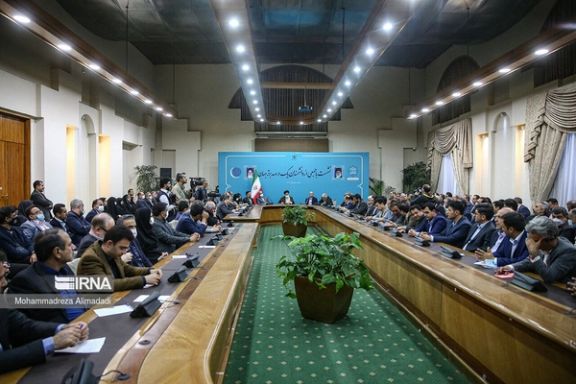
A university professor’s uninformed claim that the Python software program can 'predict the future' has caused new embarrassment for the government in Iran.
A one-minute video emerged Wednesday of a March 28 meeting between President Ebrahim Raisi and academics allegedly in the “top one percent of world scientists” during which one of the participants makes hugely uninformed remarks while the president listens with interest and takes notes.
The meeting was apparently organized by the ministry of science, research and technology and over 100 of the “top one percent [Iranian] scientists” attended.
University professor, Davood Domiri-Ganji, suggests to the president that the “Python universal software” and “Python global network” could be used to predict the future in the fields of medicine, military, and economic developments such as the growth of inflation “in the next four years”.
The mistake does not appear to be a slip of the tongue as Domiri mentions it several times and even claims that there is artificial intelligence “inside” the human body.

Domiri-Ganji’s major gaffe, apparently mistaking the Python computer programming language for artificial intelligence, has caused an uproar in the media and social media, even pushing the word Python to the top of Persian language hashtags on Twitter.
“These vulgar remarks angered many because everyone knows that Python is a simple programming language … but not everyone knows what inflation is or what shapes the rate of foreign currency exchange,” Sadegh Alhosseini, a prominent economist, said in a tweet while warning about the consequences of giving such uninformed individuals a role in policymaking.
Domiri-Ganji, is a mechanical engineer, a former head of Amol University of Special Modern Technologies and the National Elites Foundation of Amol. He is currently a professor and research deputy at Babol’s Noshirvani University. According to Iranian media, Domiri-Ganji has close ties with the hardliner political establishment and media. According to his Google Scholar page, he has published dozens of scientific articles.
The issue is not just the uninformed suggestion of the said professor, former Iran newspaper journalist Ehsan Bodaghi who dubbed the incident as “Python-Gate” said on Twitter. “Even worse is the fact that there wasn’t even one person among all those ‘top one percent of world scientists’ to know what Phyton is and to point out that it was nonsense.”
Bodaghi has also pointed out that this incident and other cases when hardliners have made hugely uniformed remarks, or carried out scientifically baseless projects with government money, are the result of involving ideology and politics in technical and scientific matters. “The outcome is the circumstances we are witnessing now,” he wrote.
One of the cases that Bodaghi and many others have mentioned is the claim of invention of Corona virus detector in early 2020 by the Revolutionary Guards (IRGC). The machine which was presented to the public by the IRGC Commander-in-Chief Hossein Salami in April 2020 at a televised ceremony appeared to be only a fake bomb detection device that was first sold by James McCormick, a British fraudster, to Iraqi security forces.
“There are still many honorable, knowledgeable, patriotic and ethical individuals in Iranian universities but in a symbolic manner, Python-Gate is indicative of the decline that has overtaken universities,” said Mohammad Fazeli, a former professor of sociology at Shahid Beheshti University who was expelled for political reasons in a tweet Wednesday.
“No-one knows of this decline and is aware of the procedures leading to its existence better than academics themselves,” he added. Coining the word “Pythonism” to refer to uninformed and pseudoscientific theories that are put to action by the authorities, Fazeli warned that such theories are gaining traction and forming the basis of policymaking in Iran.
Python-Gate has also sparked a host of jokes on social media. “One should use Python to look at the next four years to see if these mullahs are going to be gone by then or not,” one tweeter wrote.

Israel will not allow Iran to obtain nuclear weapons, with or without help from others, Israeli Prime Minister Benjamin Netanyahu told local media on Thursday.
As Iran and all its allies and proxies in the region marked the Quds Day, a designated day to support Palestinians and condemn Israel, Netanyahu told Israel’s channel 14 in an interview that the issue of Iran’s nuclear weapons depends on him and he will not allow it.
His statement about preventing Iran’s nuclearization “With or Without help from others”, presumably referring to a possible role by the United States, echoed a statement by former Israeli National Security Advisor Yaakov Amidror, who said on Thursday, “We need to prepare for war. It’s possible that we will reach a point where we have to attack Iran even without American assistance.”
Iranian media widely reported Amidror’s statement on Friday, as the Islamic Republic’s various government institutions pushed to get a big turnout during the Quds Day, anti-Israeli marches.
Fars news agency affiliated with the Revolutionary Guard recycled past statements by the Supreme Leader Ali Khamenei, saying that when Iranian officials call for the “eradication of Israel” they do not mean the Jewish people, but the current state of Israel.
Eradicating Israel, Khamenei was quoted as saying means “The Palestinian people, who are the real owners of that land, whether Muslim, Christian or Jewish electing their real government…and expelling thugs such as Netanyahu” who are foreigners.
Khamenei, his loyalists and government-controlled media in Iran have been claiming in recent weeks that end of Israel is near, after Israeli protests against Netanyahu and Palestinian terror and rocket attacks.
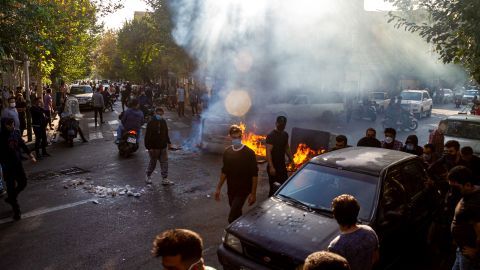
A Twitter account dedicated to news about protests in Iran has released a batch of death certificates of those killed by security forces.
The activist account 1500 Tasvir, which runs popular Instagram and Twitter accounts, started uploading the documents on Wednesday.
The account also published a large batch of harrowing photos and videos of people shot or killed by the regime late in March, saying that such documentation must remain forever in the country’s history.
The cause of death for hundreds of people who died during the protests of "Women, Life, Liberty” movement is stated as "unknown", and the death certificates of dozens of others attested the use of "live fire and bullets" as the cause of death.
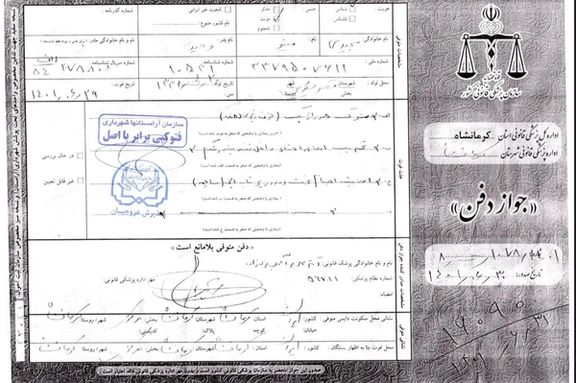
Other causes of death mentioned in the certificates are ruptures of veins or blood vessels, crushing of the skull, hemorrhagic shock (loss of a large volume of blood), and severe tissue damage, all of which point to injuries caused by the security forces’ bullets and batons.
In several cases, the words live fire or bullet are intentionally avoided and replaced by alternative terms such as "accelerated metal projectile" or “metal object."
There are several cases in which the cause of death is declared as “unknown” despite testimonies by eyewitnesses who were present at the scene and directly testified otherwise. These include the cases of Mehrshad Shahidinejad and Sina Malayeri, two protesters who were beaten to death by batons during rallies in the city of Arak according to eyewitnesses.
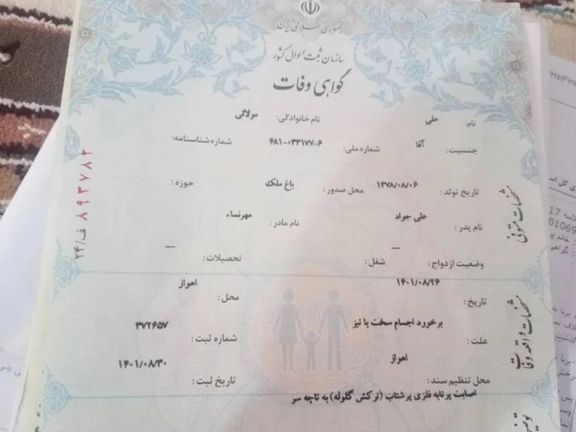
In one of the certificates published by 1500tasvir, the cause of the death of Behnam Layeghpour was declared as “violence by other protesters” despite his family's account of the incident. Layeghpour was reportedly shot two times in his throat and chest from close range in October as his fiancée was watching. A security agent stood over him and prevented people from helping him at gunpoint.
Human rights sources have reported the death of over 500 protesters, including about 70 children, during nationwide protests sparked by the death of 22-year-old Mahsa Amini in the custody of hijab police in September 2022.
There are no official reports about the number of casualties but several rights groups, such as the US-based Human Rights Activists News Agency (HRANA), have put the death toll at way more than 500.
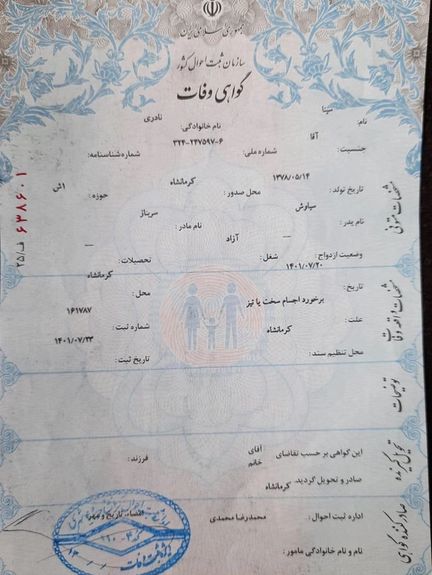
In addition to the people who were killed during the regime’s crackdown on street protests, the Islamic Republic has also stepped up its executions in the past several months.
Iran Human Rights organization and the ECPM (Ensemble contre la peine de mort or Together Against the Death Penalty) released on Thursday their latest annual report on the death penalty in Iran, revealing that 2022 had the highest annual number of executions since 2015. At least 582 people were executed, an increase of 75 percent compared to 2021.

The report said that in 2022, the Islamic Republic’s authorities “demonstrated how crucial the death penalty is to instil societal fear in order to hold onto power,” adding that 88 percent of all executions (511), were not announced by the regime.
According to the report, at least 15 people, among them two protesters, were executed for security-related charges. It also claimed that hundreds of protesters were facing show trials at the Revolutionary Courts, many with charges punishable by death.